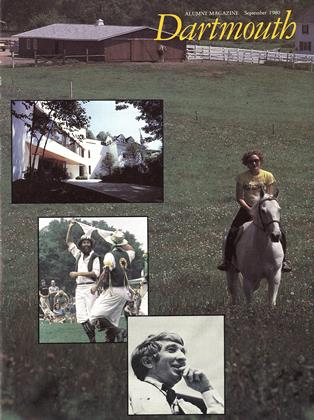YESTERDAYS: Popular Song in America by Professor Charles E. Hamm Norton, 1979. 533 pp. $24.95
This is a splendid book, unique in its breadth and depth, based on fresh study and research, skillfully organized, and delectably written. Its subject is popular song in America from the 18th century to the 1970s. Thus, it is a history, and a history moreover of the highest type: Not only do we learn about the past but we come away knowing more about the present that is, how we have been shaped by the past.
Quite apart from the fact that Yesterdays deals with a genre neglected, for the most part, by "serious" scholars, it is one of the most significant works of musical scholarship in recent years. Pop songs and scholarship? Indeed so, when a scholar of Professor Hamm's distinction (he is chairman of Dartmouth's Music Department and a past president of the American Musicological Society, among other things) turns to a subject as culturally significant as American song, with a sharp but sympathetic eye. In Yesterdays, he has produced a first-class music-historical contribution, one based on the most rigorous scholarship which is, however, handled so adroitly that it never interferes with the brisk pace of the history of its main "story line."
Look closely at the subtitle: The book is about "popular song in America," not just "American" popular song. Thus, Hamm deals at length with 18th-century British concert and stage music, with Thomas Moore's Irish melodies early in the 1800s and Italian opera and German song later, with the Beatles in the 1960s (along with home-grown songs all along the line) because such foreign elements were taken up enthusiastically by Americans, were in fact the heart of the pop songs of their time. As for the meaning of "popular song," Hamm has a very careful definition: It is a piece of music "written for... a single voice or a small group of singers, accompanied...; usually first performed and popularized in some form of secular stage entertainment, and afterward consumed (performed or listened to) in the home; composed and marketed with the goal of financial gain; designed to be performed by and listened to by persons of limited musical training and ability; and produced and disseminated in physical form...." This means that Hamm does not discuss church music (no matter how popular "The Old Rugged Cross"); folk songs (they are not transmitted in physical form but by oral tradition); band music by Sousa, piano rags by Joplin, or most jazz (all of them instrumental, not vocal). What he does discuss is what he calls the "continuous, unbroken, and coherent history of some two hundred years" of popular song.
He proceeds chronologically, and his chapter divisions mirror the changes in the popular preferences the fashionable modes in American song (song style being as mercurial and reflective of changing taste as hautecouture). Our Colonial and Federal-era taste was, of course, dominated by our English orientation. The immense popularity of Moore's Irish Melodies swung the balance somewhat and, following the 1820s and the importation of Italian opera (Rossini, Donizetti, Bellini), the stage was set for our first great native song- writer, Stephen Foster. Among the many myths that Hamm convincingly demolishes is the one that has Foster indebted to slave songs and black musicians. There are fascinating chapters on the songs of blackface minstrelsy and the Civil War; then, in the late 19th century, on the impact on our taste in song of the massive immigration of Eastern Europeans, on vaudeville, and on the birth of Tin Pan Alley.
In dealing with the 20th century, Hamm is particularly good at catching the spirit of an era in the nature of its songs and their lyrics. The last three chapters are especially brilliant in their original and persuasive analysis of the relationships between pop songs of the thirties and forties, rock 'n' roll of the fifties and early sixties, and rock of the later sixties and seventies and between the social and ideological implications of such songs, from each of these eras, as "It's Only a Paper Moon," "Rock Around the Clock," and "Sympathy for the Devil."
Yesterdays is full of illustrations (not too well reproduced, unfortunately), has many musical examples (although one need not know how to read music to profit from, let alone enjoy, the book), and a number of interesting appendices that list the most popular songs at various times.
Professor Hitchcock, director of the Institutefor Studies in American Music at BrooklynCollege of the City University of New York,has written several books on American music,the best known being Music in the United States.
 View Full Issue
View Full Issue
More From This Issue
-
 Feature
FeatureThe Dartmouth Animal and The Hypermasculine Myth
September 1980 By Leonard L. Glass -
 Feature
FeatureMonitoring Nature's Big Blow-Up
September 1980 By Dan Nelson -
 Cover Story
Cover StoryHorsin' Around
September 1980 By Marsha Belford -
 Article
ArticleCombating the Crippler
September 1980 By D.M.N. -
 Article
ArticleColor, Charm, Whatever
September 1980 -
 Article
ArticleSteel Elected
September 1980
Books
-
 Books
BooksFACULTY PUBLICATIONS
December 1942 -
 Books
BooksTHE SOVIET DESIGN FOR A WORLD STATE.
July 1960 By CHARLES B. MCLANE '41 -
 Books
BooksBut No B-52's
October 1975 By JOHNHURD '21 -
 Books
BooksTHE MIND OF CHINA
June 1933 By Robert A. McKennan -
 Books
BooksAMERICAN HISTORY.
December 1961 By ROBERT E. RIEGEL -
 Books
BooksFACULTY PUBLICATIONS
February 1921 By Wilbur M. Urban

